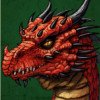I totally ripped the basis of this out of my other article. It didn’t really fit in with that main thesis anyway, and I came up with a train of thought that could be even more fun when played off of Dr. Jone's idea. I’m always playing with theories about how dragons have influenced this world without actually leaving behind physical evidence (at least none that have yet been discovered). So without further a due, here’s what I did this time:
There are many questions as to why the dragon remains a constant symbol for mankind. The speculation that they were actually real is still controversial, though exceedingly put down by scientific research. Yet there are still many who hypothesize other theories as to why the dragon supposedly resided even in the most isolated of areas and is depicted in a majority of human cultures. One theorist, Dr. David E. Jones, anthropology, Univ. of Central Florida, has his own hypothesis based on dragons and the collective unconscious. He believes that dragons are a direct result of the human evolutionary process.
In his book, An Instinct for Dragons, Jones explains that the idea of a dragon is hardwired into our brains. "Over millennia," he writes, "the raptor, big cat, and serpent began to form as a single construct-the dragon--in the brain/mind of our ancient primate ancestors." Dr. Jones first obtained his idea from the behavior of vervet monkeys in Africa. They have three different alarm calls that provoke three different defensive responses: one for the leopard, one for the martial eagle and one for the python. Dr. Jones felt that these three predators made up the idea of a dragon as a means of survival. This may help explain why every culture, no mater how isolated, has a dragon legend. The editors of SCIENTIFIC AMERICAN write: “Most of the 40 illustrations in the book portray dragons as different societies envisioned them. The common theme is that they look scary” (Jones, 2004).
Though a bold statement, Dr. Jones’s idea does bring about a certain amount of thought. These three creatures spoken of, the serpent, big cats, and bird of prey, all compose the image of a dragon when combined. Not only in appearance, yet even the challenge they had once presented mankind also rivals that of the influence that the dragon has had upon us. They were the prehistoric man’s rivals and largest competition. This can be drawn back into the nature that dragons seem to have. They are either a challenge to overcome or a great force to be reckoned with.
The varying appearance of dragons is based on the culture which perceives them. Although they may look different, yet a dragon can be viewed in almost any culture, no matter how isolated. The three main predators also have different appearance depending on the location they are in. These changes are what may give us the dissimilar manifestations of dragons in separate civilizations.
Taking that a step further, one could speculate whether or not individuals can tap into that collective unconscious and relate it to a part of themselves. Or more specifically, people who associate so strongly with that universal concept of dragons to the point that they may see dragons as a part of their identity. There are individuals who view themselves as dragons and thus consider an aspect of themselves as other than human. Dr. Jones’s theory could be one way to describe why some people would feel this way about themselves. The term that has come about to refer to individuals who feel such a way about themselves is ‘dragon otherkin’.
The otherkin phenomena is an area of psychology that has not yet been thoroughly explored, much less explained. Within the community, members have come up with various theories as to why they feel this way about themselves. They range anywhere from that of a spiritual sense like reincarnation, one of the mind such as a different mental state, or one of the senses, for example a different physical perception of what they feel. The theory I mentioned earlier might be another one used to more psychologically explain the experience which dragon otherkin seem to have in regards to how they identify themselves.
Many of these individuals do not openly share this aspect of themselves for fear of isolation and social derision. This is understandable since the concept of otherkin is rather bizarre, especially when not explained fully, thus the impression given is of an individual who is may not be stable. While for some this could be the case, overall the community comes across as being more inquisitive about their beliefs, and capable of rationally theorizing them.
The concept of this actually being associated to the natural connection we as a human race have with one another can lead to a fascinating connection between people and the symbols we have all used. Some can still mean the same thing to us over time, no matter the remoteness of our cultures. Taking the example even further, this concept may not be limited to just explaining dragons, but various types of otherkin as well. It may be a possibility that those who find themselves identifying with the symbol their kin type could mean to them may be channeling it into themselves to the point where it shines threw their very essence. Thus it may be identified as such by others due to how universal a symbol it may be that the individual portrays.
A Theorized Instinct for Dragons
1 post
• Page 1 of 1
A Theorized Instinct for Dragons
Home is where the hoard is


-

chaitea - The Ship's Doctor

- Posts: 920
- Joined: Thu Jan 10, 2008 4:23 pm
- Location: PA
- gender: female
- kin type: Dragon
1 post
• Page 1 of 1
Who is online
Users browsing this forum: No registered users and 3 guests
